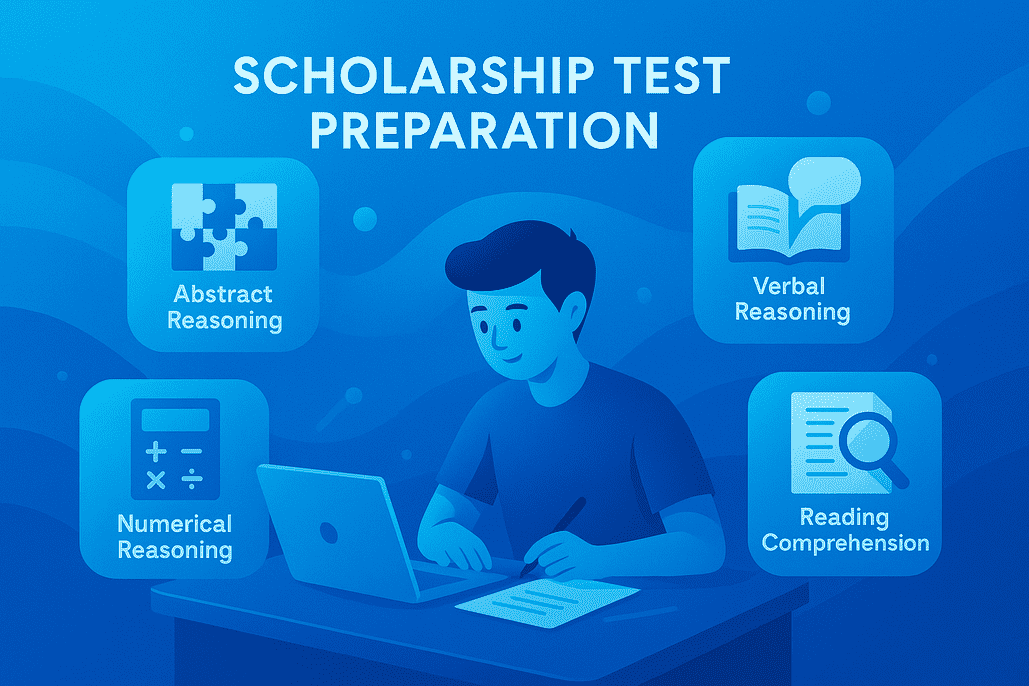For many Australian families, the ACER Scholarship Test represents more than a one-off exam. It is a structured way for schools to identify students with strong academic potential and to award scholarships that can ease financial pressure while opening doors to enriched learning pathways. Beyond fee support, scholarships often come with intangible benefits that endure long after graduation:accelerated curricula, specialised programs, academic mentoring, and a peer group that values scholarship and curiosity.
Preparing for this assessment can feel daunting because its question styles, timing, and difficulty differ from those of typical classroom tests. The good news is that students can prepare strategically rather than as a marathon of memorisation. The test prioritises reasoning over rote recall; accordingly, the most effective preparation emphasises skills such as reading comprehension, written expression, mathematical reasoning, and abstract thinking and performing under time constraints with composure.
This guide explains why the ACER Scholarship Test is important, what it assesses, and how families can build a clear, practical plan. It also outline show NotesEdu, through ACER-style courses, reading and writing programs, full-length tests and interview preparation, can help students practise realistically and track progress..
For official information about test purpose, levels and participating schools, see the ACER Scholarship page.
Why the ACER Scholarship Test Matters to Students and Parents
Tangible benefits for families
- Financial support can help alleviate school fees and other education-related expenses.
- Program placement often aligns students with extension or accelerated pathways that match their learning pace.
- Learning environment: peers who enjoy challenge can encourage persistence, healthy competition and academic confidence.
- Future pathways: scholarships can strengthen a student’s record when applying for later programs or opportunities.
Skill development that outlasts the exam
Preparing for ACER effectively encourages habits that benefit students across the school:
- Reading more demanding texts and extracting meaning under time constraints.
- Writing clearly to a purpose and within set parameters.
- Solving unfamiliar quantitative and non-verbal problems logically.
- Managing time and focus in pressured settings.
The test acts as a catalyst for building these durable capabilities. Even when a scholarship is not ultimately offered, students often report improved classroom performance and greater exam confidence because preparation has targeted transferable reasoning skills.
What the ACER Scholarship Test Assesses
Core areas
While exact compositions vary by level and school usage, ACER scholarship assessments commonly target:
- Reading Comprehension: interpreting complex passages, identifying primary and supporting ideas, inferring meaning, and evaluating arguments.
- Mathematical Reasoning: applying quantitative and logical thinking to novel problems rather than reproducing memorised procedures.
- Written Expression: communicating ideas with clarity, coherence and control within strict timing.
- Abstract/Reasoning: recognising patterns, generalising relationships, and responding flexibly to unfamiliar visual or mixed-mode stimuli.
Why this matters
These domains reflect higher-order thinking that extends beyond routine class exercises. Students who thrive tend to:
- Read closely and quickly without sacrificing accuracy.
- Translate words into structured reasoning steps.
- Organise written responses to a clear purpose.
- Stay calm when an item feels unfamiliar, using elimination and estimation.
Preparing with these qualities in mind keeps the study focused on what ACER is actually measuring.
A Practical Preparation Roadmap
1) Map the journey early
- Clarify timelines: shortlist participating schools, note registration windows and test dates, and plan backward to ensure a smooth process.
- Baseline your skills by using one initial ACER-style practice test to identify your strengths and gaps.
- Schedule consistency: shorter, focused sessions (e.g., 3–5 times per week) are more productive than occasional long blocks.
2) Build the foundation: reading and writing
Strong reading and writing underpin success across the assessment. Prioritise:
- Wide, level-appropriate reading: editorials, feature articles, short stories, and science explanations.
- Purposeful annotation: summarise main claims, evidence, author stance and tone.
- Timetabled writing: practise short, purpose-driven responses with attention to structure and clarity.
How NotesEdu can help
- ACER Reading & Writing Course – structured lessons for comprehension strategies and written expression practice aligned to scholarship demand.
- ACER Scholarship-Style Reading Test – timed passages with detailed explanations to build stamina and precision
3) Strengthen mathematical and abstract reasoning
Focus on reasoning steps rather than memorising procedures:
- Translate words into quantities and relationships; sketch or use a table when helpful.
- Check for reasonableness using estimation.
- Practise pattern recognition and rule inference in abstract sequences.
How NotesEdu can help
- ACER Platinum (secondary) – extensive reasoning banks, step-wise solutions and timed practice mirroring scholarship style.
- ACER Premium Primary Scholarship (primary) – level-appropriate content that scaffolds strategies for younger candidates:
4) Rehearse the real thing: full-length tests and review
- Simulate conditions: sit ACER-style tests end-to-end with strict timing, minimal interruptions, and exam materials only.
- Review with intent: classify every error like misread, concept gap, time-pressure mistake then select a small set of targeted drills to close those gaps.
- Track deltas: record section scores, time spent per question, and accuracy by topic to see trends.
How NotesEdu can help
- ACER Scholarship Tests – realistic, full-length practice with detailed solutions and analytics to identify patterns and prioritise focus.
- ACER Scholarship Test Hub – a single view of NotesEdu’s ACER resources (reading, writing, reasoning, full tests) for a cohesive plan:
5) Learn under time constraints
- Practise pacing: allocate time per question or per set, and move on when stuck; return if time remains.
- Use educated elimination on difficult multiple-choice questions rather than leaving blanks.
- Build stamina: interleave shorter drills with periodic full-length sessions to maintain energy without burnout.
How NotesEdu can help
- Scholarship Practice Hub – a starting point to mix question-type drills with full test rehearsals, suitable for varied schedules.
6) Prepare for interviews (where schools use them)
Some schools supplement test results with an interview to understand motivation, communication skills and broader interests.
How NotesEdu can help
- Interview Course – guidance on common question themes, structuring responses, and mock interview practice to build confidence.
The Parents’ Role: Support Without Pressure
Create the right environment
- Predictable routine: set recurring study windows that respect extracurricular and family commitments.
- Quiet space: a decluttered, well-lit area with printouts, scrap paper and a timer.
- Healthy rhythm: adequate sleep, breaks, and movement to protect concentration.
Encourage process over perfection
- Celebrate habits (consistency, review quality) rather than chasing scores alone.
- Reframe setbacks as feedback: “What did this mistake teach us?”
- Keep discussion solution-focused: agree on one specific change for the next session.
Choose resources strategically
- Look for ACER-style alignment, clear solutions, and timed modes.
- Prefer programs with analytics so progress guides planning.
- Match materials to the student's level; materials that are too easy or too hard waste time.
NotesEdu’s ACER range is designed with these principles in mind: tiered courses for primary and secondary levels, skill-specific programs for reading/writing, realistic full-length tests, and analytics that make planning simpler for families.
Common Preparation Mistakes
- Relying on rote learning
Instead: practise unfamiliar problems; focus on reasoning steps and explanations. - Leaving practice until the final weeks
Instead, start early with short sessions and layer in timed practice as familiarity grows. - Skipping review
Instead, spend at least as much time reviewing as testing; tag each error and assign a drill to address it. - Practising only untimed
Instead, maintain a mix; add timed sets regularly to develop pace and decision-making skills. - Using generic resources misaligned to ACER
Instead, choose material written in the ACER scholarship style, with difficulty and timing that reflect the real experience.
A Sample 10-Week Plan (Adapt to Your Timeline)
Weeks 1–2: Orientation and baseline
- Read official ACER information; shortlist schools and dates.
- Take one ACER-style practice test to map strengths/gaps.
- Begin the ACER Reading & Writing Course twice weekly and Platinum/Premium reasoning sessions once weekly.
Weeks 3–6: Skill building
- Reading: timed passages from ACER Scholarship-Style Reading Tests; summarise the main idea and evidence.
- Writing: one short response per week; focus on planning, then clarity.
- Reasoning: targeted drills from ACER Platinum or Premium Primary; document common traps.
- One partial timed set is conducted fortnightly; the review is thoroughly conducted.
Weeks 7–8: Timed consolidation
- Two mini-mocks per week from ACER Scholarship Tests; practise pacing rules.
- Review with error codes; assign follow-up drills.
Weeks 9–10: Full simulation and polish
- Two full mocks under exam conditions; apply pacing and elimination strategies.
- Lighten the load in the final days; prioritise sleep, routine and confidence.
- If an interview is likely, complete the Interview Course modules and a mock conversation.
This outline remains adaptable—students can start earlier or compress thoughtfully. The principle is consistent: skills first, timing next, review always.
How NotesEdu Complements a Balanced Preparation Strategy
- Alignment to ACER style: course content and tests are designed to resemble the scholarship format and cognitive demands.
- Breadth for different year levels: primary and secondary options ensure practice is appropriately challenging.
- Structured skill building: discrete programs for reading, writing, and reasoning enable targeted improvement.
- Timed practice with analytics: performance reporting highlights where to focus limited study time.
- Interview support: a dedicated course helps students communicate calmly and clearly when schools include interviews.
Test Day: Calm, Clear and Consistent
- Logistics first: check location, arrival time, required materials.
- Warm-up, not cram: a short reading passage and a few light problems keep the mind engaged without fatigue.
- Pacing rules: move on after your pre-set limit; return if time allows.
- Process of elimination: remove clearly wrong options; make an educated choice rather than leaving blanks.
- Reset quickly: if one question is tough, don’t carry it into the next item.
Families who rehearse these behaviours in practice usually report that the real assessment feels familiar rather than foreign.
Ready to build a calm,tructured preparation plan? Explore NotesEdu’s ACER resources from targeted reading and writing to full-length scholarship tests and interview practice so your child can prepare with clarity and confidence.
Disclaimer
This article providesgeneral information to help families understand scholarship testing andpreparation options. Preparation is not compulsory, and nomethod can guarantee specific scores or scholarship outcomes. Resultsdepend on each student’s abilities, effort and performance on the day. NotesEduis not affiliated with ACER.
















